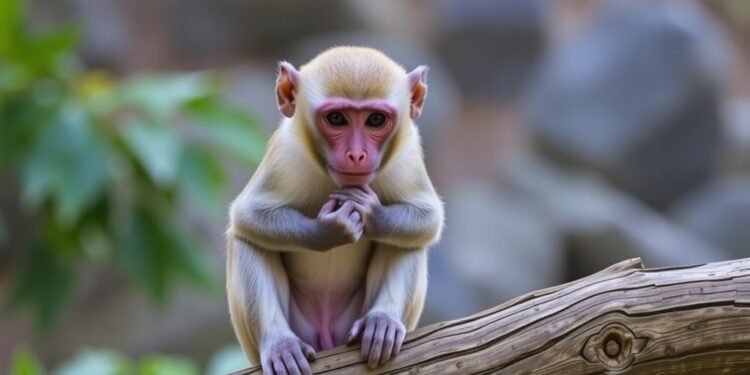In a groundbreaking study led by researchers from UCLA, a noteworthy investigation into the survival mechanisms of white-faced capuchin monkeys during environmental stress underscores the value of understanding physiological responses to climate-induced challenges. The study, which delves into the relationship between stress responses and survival, specifically during drought conditions, provides a fresh perspective on how these primates navigate extreme environmental adversity.
The research team utilized fecal samples collected over six years leading up to the notable El Niño drought, which devastated regions across Central and South America from 2014 to 2016. This unique approach offered insights into how certain physiological stress responses could correlate with survival rates during severe environmental stressors, such as prolonged droughts. The findings emphasize that some individuals exhibit a more pronounced endocrine response during less severe droughts, potentially enhancing their resilience during extreme conditions.
Through this comprehensive study, the researchers discovered that monkeys demonstrating a significant increase in glucocorticoid levels—a class of steroid hormones linked with stress—during mild droughts showcased a higher probability of surviving the subsequent extreme El Niño drought. This adaptive physiological response emerged as a crucial factor in the survival strategies of the capuchins, marking a fascinating shift in our understanding of stress in wild primates.
The investigation highlights the importance of exploring physiological stress responses beyond the traditional lens of "wear-and-tear." Instead, the researchers focused on how these responses could enable individuals to withstand significant challenges. The results suggest that increased glucocorticoid levels may serve as a preadaptive defensive mechanism, preparing individuals for harsher realities ahead.
To conduct this research effectively, the team relied on a natural experiment rather than a controlled experimental design. The devastating El Niño drought provided an unintentional opportunity to observe the monkeys’ stress responses and their consequences on survival. By leveraging previously collected samples, the researchers could analyze hormonal fluctuations in response to ecological changes, allowing them to glean valuable insights into the adaptive nature of stress responses in wild primates.
Field studies like this one, conducted over an extensive period, demonstrate the advantages of longitudinal research in understanding the impact of climate change on wildlife. As climate fluctuations become more pronounced on a global scale, such studies can inform conservation efforts and provide guidance on which species might thrive amidst rapid environmental shifts. The findings stress the urgency of documenting how wildlife communities respond to ongoing and future climate challenges.
The implications of this study extend beyond the academic realm; they carry significant conservation relevance. For instance, animals struggling to adapt to changing conditions may be at risk of extinction. This knowledge could inform wildlife management decisions, such as relocating vulnerable populations to areas with suitable climatic conditions. Understanding stress responses across various species could become a cornerstone of effective conservation strategies.
In the case of the white-faced capuchins, particularly alarming factors surfaced during the El Niño drought. Monkeys began to demonstrate marked signs of distress, including significant weight loss and abandonment of caregiving roles by mothers. Usually adept at altering their behaviors in response to environmental stressors, the monkeys appeared unable to adapt during this crisis. The situation emphasized the severity of the drought and the far-reaching consequences on their social dynamics.
This exploration into the capuchins’ survival strategies also illuminates the broader narrative surrounding climate change and its effects on ecosystems worldwide. As precipitation patterns shift and temperatures rise, understanding the nuanced interplay of ecological stress, individual physiology, and survival remains crucial to predicting how various species might fare in a changing climate.
The study provides a richer understanding of the white-faced capuchins in their natural habitat. The meticulous data collection and analysis present a compelling picture of how individual differences in stress responses may impact survival outcomes. This research might also pave the way for further inquiries into the evolutionary implications of such physiological adaptations.
Furthermore, the collaboration among researchers from diverse institutions highlights the collective effort necessary to address complex ecological questions. Susan Perry, an evolutionary anthropologist, along with her colleagues, showcases how interdisciplinary cooperation can drive scientific exploration forward, yielding insights that single disciplines may overlook.
The research also sparks interest in investigating the underlying mechanisms behind individual variability in stress responses. Identifying factors that contribute to differences in glucocorticoid levels may unveil evolutionary advantages that certain traits confer in dealing with environmental stress. After all, understanding these biological underpinnings is inherently linked to the survival of various species amidst unprecedented climatic changes that are reshaping our planet.
As global temperatures continue to rise, and extreme weather events become increasingly commonplace, studies like this serve as critical reminders of the necessity for ongoing research into wildlife adaptation. Such initiatives will not only enhance our comprehension of specific species but ultimately foster a greater appreciation for the delicate balance of ecosystems in the face of human-induced climate change and natural disasters.
In summary, understanding how white-faced capuchins adapt to environmental adversity shines light on the broader challenges many species may face as climate conditions evolve. This exploration into the interplay between stress responses, survival, and environmental pressures reveals fundamental truths about adaptability and resilience, propelling the conversation about conservation and ecological integrity forward.
Subject of Research: Survival Mechanisms of White-Faced Capuchin Monkeys During Environmental Stress
Article Title: Enhanced Stress Responses Improve Survival of White-Faced Capuchin Monkeys in Drought
News Publication Date: October 2023
Web References: Science Advances
References: N/A
Image Credits: N/A
Keywords: White-faced capuchin monkeys, stress responses, drought, survival, climate change, glucocorticoids, environmental stress, conservation, long-term studies, evolutionary adaptations.




